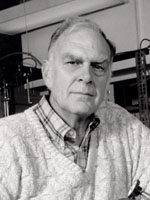
F. Sherwood Rowland
University of California at Irvine
From Hot Atoms to the Stratosphere
In the summer of 1952 I received my Ph.D. in radiochemistry from the University of Chicago, working with Willard Libby. Newly married, I went off that fall to Princeton’s department of chemistry as an instructor. The following summer I attended the Nuclear Chemistry Gordon Conference at the New Hampton School in New Hampton, New Hampshire.
The physical sciences had undergone an enormous change during the 1940s, the product of spectacular changes in government funding during World War II. Nuclear chemistry had grown from a few scientists working with natural radioactivity to the use of ever-larger particle accelerators, nuclear reactors, and elaborate measuring equipment, much of it related to the development of nuclear weapons.
During the course of the wartime Manhattan Project a variety of new chemical specialties had arisen. In the early postwar period the Nuclear Chemistry Gordon Conference covered a broad spectrum of topics, including transuranium elements, radiation chemistry, new chemical separation techniques, age dating based on uranium and Libby’s carbon-14, and my own niche, “hot atom” chemistry, which examines the unusual chemical reactions of radioisotopes as they emerge newly created with enormous energies on a chemical scale. As an example, tritium–the hydrogen isotope of mass three (hydrogen-3)–is created when a free neutron reacts with the nucleus of the stable isotope lithium-6 and is released with an energy of 2,700,000 electron volts. The triton (the singly charged nucleus without an electron) careens through its environment, leaving a long trail of molecular destruction. Eventually it picks up an electron and continues to move through the environment as an energetic neutral tritium atom. Only at the very end of its path does its energy decrease to a level roughly comparable to the strength of a carbon-hydrogen bond–4 to 5 electron volts–and undergo a final bond-forming collision. Because the tritium atom is radioactive, it can still be detected at the end of this trail whatever its terminal molecular form. Frequently, with very high kinetic energy in this last collision, such radioactive atoms end up in molecular forms inaccessible to thermal hydrogen atoms.
Those of us who entered radiochemistry just after World War II were thrown in with scientists only slightly older who had pioneered new techniques and invented new equipment in the Manhattan Project and had also collected lists of potential peacetime experiments. The postwar era had also brought the creation of Brookhaven National Laboratory, with its summer appointments for academics, and in the summer of 1953, I traveled to New Hampshire with the Brookhaven contingent for my first Gordon Conference. I was twenty-five. The authors of the leading radiochemistry text, Gerhart Friedlander and Joe Kennedy, were in their mid-thirties. Even such world-famous “senior” scientists as Glenn Seaborg and Willard Libby were still in their forties. We were collectively young enough that sports dominated the afternoons, and pranks were not unknown. At four in the morning one of the thirties age group led an intrepid band who sneaked into the New Hampton School bell tower to ring the bell in close proximity to Seaborg’s room.
Soon after, nuclear chemistry fissioned into radiochemistry, which used radioactivity to study problems involving molecular structure and chemical kinetics, and “nuclear-squared” chemistry, which focused on changes in the nucleus. The Gordon Conferences expanded as well, and most of us began attending conferences that addressed more narrowly defined areas, including radiation chemistry, stable isotope chemistry, geochemistry, chemical kinetics (with radioactive tracers), photochemistry, and isotope effects in chemistry and biology.
In a chance 1970 conversation on an Austrian train after a conference in Europe that was similar to a Gordon Conference, I mentioned to an Atomic Energy Commission (AEC) acquaintance that I had a strong residual Libby-inspired interest in the radioisotopes produced in nature by cosmic radiation. Ultimately, this resulted in an invitation from the AEC to another meeting, one which deliberately mixed two nearly immiscible groups–chemists and meteorologists. There I heard of measurements confirming the presence everywhere in the surface atmosphere of CCl
3F (trichlorofluoromethane), also known as CFC-11. Mario Molina and I explored the fate of CFC-11 in the natural environment, and soon my Gordon Conference of choice became Atmospheric Chemistry, which had gone beyond air-quality and environmental science into the global questions of stratospheric ozone depletion and greenhouse gases. I remained interested in the use of both radioactive and stable isotopes in various milieus, but especially in atmospheric surroundings.
The first Gordon Conference I attended gave me my initial experience in associating with colleagues from everywhere, under conditions where a follow-up discussion to a lecture could happen right afterward in the bar or days later on a tennis court. The GRC parent organization has greatly expanded the opportunities for interactions among scientists, and the organization has been emulated by others around the world. GRC’s growth has helped spread this unique approach to sciences other than chemistry, and I am sure it still works as well for newly minted scientists as it did for me fifty years ago.